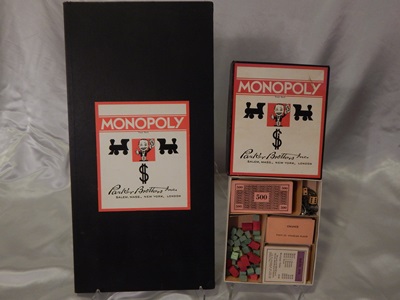

Armed with a cash surplus from early sales of the game, they added the tactic of making financial deals to remove knockoffs from the market, such as when a game called Inflation came out. And Parker Brothers was ready for the imitators they knew would follow. Their perception was right-the game was a hit as soon as it went into production. They also saw it as an affordable game during the Great Depression that allowed people to experience the thrills of buying property and accruing fortunes. So, when Monopoly came across the desks of George and Charles Parker, they saw a game that they not only could call their own but was unique enough they could enforce that claim. Throughout these experiences, Parker Brothers developed a keen business acumen. But even with the knock-offs, Parker Brothers found success as a trend of “Mah-Jongg nights” started, which included Chinese food, Asian-style robes, silk screens, and even hiring Chinese moderators “to act as a sort of major-domo of the play.” This success showed that a hit could launch to superstar status if it resonated with the culture of the times. Babcock) in 1923 but couldn’t prevent a wide range of similar products popping up in the marketplace.

Parker Brothers smartly obtained the trademark from the source (i.e. As part of that trend, a Standard Oil engineer named Joseph Babcock brought back to America the Chinese game of mahjong.

Following World War I and the increased globalization of the 20th century, a fascination with foreign cultures emerged. Mah-Jongg-Some games become hits because they fit the culture of the times. Here was evidence that imitators not only hindered profits, they could even damage a product’s image. And by 1910, Diabolo’s spinning success had slowed so much it was absent from the Parker Brothers catalog (though Ping-Pong and Tiddledywinks remained). Many knockoffs were made of cheaper materials and did not have the same frictionless spin of the Parker Brothers version. But, yet again, competitors followed suit with their own devices, which may have also put an end to the trend. Parker Brothers obtained the rights from Phillipart and received a U.S. Diabolo has mechanisms similar to a yo-yo and involves using two wands and a string to launch a spinning hourglass-shaped device into the air. Parker would need to do more than just lay claim on the name, he would need a unique product.ĭiabolo-Diabolo is another plaything of contested origin, but at least the name “Diabolo” can be attributed to French engineer, Gustave Phillipart. The product turned into an immense success, but it wasn’t long before other companies started making an eerily similar product called table tennis. rights, and again he applied for a trademark, but this time it went through. Ping-Pong-In 1902, George Parker traveled to England and discovered a game made possible by recent advances in plastics, Ping-Pong. Unfortunately, the game was deemed “too generic” to qualify for a trademark, and imitators soon rushed their own versions to market. For those unaware of the title, Tiddledywinks is a game where players apply pressure to plastic discs so they pop up in the air, with the goal usually being to launch them into a cup. In the 1890s, that paid off when the company acquired the rights to the New Round Game of Tiddledywinks. Tiddledywinks-Parker Brothers was one of the first American game companies to set up trade relations with game makers in England. So here are some highlights of those early hits, which may shed some light on why Parker and his compa ny were so set on claiming Park Place, Boardwalk, and all the others for their own. But if you turn a few pages earlier in the story, you will see many early Parker Brothers successes had been marred by imitators and knockoffs. One reason is that Magie’s original creation was designed to teach the dangers of capitalism and property ownership, which ran counter to Parker’s drive to exclusively own this title for maximum profit. The details of this pursuit of a monopoly on Monopoly have elicited criticism from some. And as the founders of Parker Brothers, specifically George Parker, learned the game’s authorship might be unclear, the company moved swiftly to secure the rights from anyone who had a claim on the game. A lot happened in between those dates, including other versions of the game showing up in homes and stores courtesy of other alleged or unknown inventors. What started as The Landlord’s Game, patented by Elizabeth Magie in 1904, eventually became a game called Monopoly that Charles Darrow sold to Parker Brothers in 1935. The Strong recently released an online exhibit on the early history of Monopoly, and it details the complex origins of one of the world’s most iconic games.


 0 kommentar(er)
0 kommentar(er)
